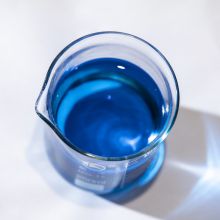Silk Amino Acid
USD $2750 - $2857 /Kilogram
Min.Order:500 Kilograms
Quick Details View All >
Sichuan Shihong Technology Co., Ltd
Hydrolyzed Protein Amino Acid Liquid Fertilizer 30% ph3-5 Organic Foliar Spray N 7%
Soybean Meal Fermentation Amino Acid 50% Liquid Organic Fertilizer
Soybean Meal Amino Acid Liquid 45% Organic Fertilizer Mirconutrients Compound Amino Acid
Hydrolyzed Amino Acid Powder 80% Yellow Powder Total Nitrogen 13%
Product Details
Silk Amino Acid
CAS | 96690-41-4 |
Amino Acid | ≥90% |
EINECS No | 306-235-8 |
COSING REF No | 37698 |
Appearance | White Powder |
pH | 5.0~7.0 |
Solubility | 100% soluble |
Total nitrogen | ≥14.5% |
Package | 20KG/Bag |
Crystalline water | None |
WHAT’S UP WITH SILK AMINO ACIDS?
Also known as silk protein or sericin, Silk Amino Acids are protein molecules that bind silk fibers together for silkworms, hence, the name. Silk protein is a very rich source of amino acids and in fact has over 18 different amino acids. Because of their rich nutrient properties, silk aminos help reduce fine lines and eliminate signs of aging. The amino acids found in these specific protein molecules can also rejuvenate skin tone, reduce wrinkles, and hydrate skin tissues. As a hair care ingredient, silk protein is known to penetrate hair to treat damage and preserve moisture.
WHY DO WE USE SILK AMINO ACIDS IN TREEACTIV PRODUCTS?
The amino acids have been found to have a low molecular weight, which allows them to easily penetrate the hair cuticle and the upper layers of the skin. Silk protein binds to the keratin in hair to treat damage and add a protective barrier that seals in moisture, making hair more manageable and less prone to breakage. The extra hydration also leads to increased length retention, less frizz, and softer hair. Just like with hair, Silk Amino Acids is known to bind with keratin that’s found in the skin to retain moisture, thus helping to hydrate skin. Studies have found other skincare benefits such as blocking harmful ultraviolet rays, strengthening skin’s resistance to damage, and acting as an antioxidant to prevent premature wrinkles.
Silk amino acid (SAAs) also known as Sericin is a natural water-soluble glycoprotein extracted from raw silk. It is used as an additive in skin and hair care products due to its high levels of serine which has excellent moisture preservation characteristics. As a water-based additive it is used to provide a protective barrier and silky feel to lotions, soaps, personal lubricants, hair and skincare products. Silk amino acids are produced by hydrolyzing (or breaking apart) silk proteins into smaller peptide chains, typically 18 to 19 amino acids in length. Silk amino acids have a lower molecular weight than silk protein powders and are moisturizing to skin and hair.
Silk amino acids are used in formulating shampoos, conditioner, hair treatments, bodywash, body lotions, cleansers, toners and facial moisturizers, mascara, lipstick and color cosmetics.
Background
Silk is made up of two primary proteins; a fibrous protein known as fibroin, and a sticky protein known as sericin, with the two comprising 70–80% and 20–30% of silk, respectively. Both of these proteins provide the unique functionality of silk that makes silk clothes so unique and so popular, with the production of silk material dating back to as early as 3500 BC. What is not so well known though is that silk has been used in traditional medicine in both China and Korea for centuries.The source of these silk amino acids is typically the domesticated moth, silkworm.
Sericin has a high hydroxy amino acid content which is important for the water-binding capacity which regulates the skin's moisture content. It also has a unique carbohydrate moiety and a unique repetitive amino acid sequence which give it a high affinity for bonding to adhering proteins resulting in a tightening, anti-wrinkle effect. In addition, because of its high molecular weight, it leaves a substantive semi-occlusive film that persists even after washing, and can increase the skins permeability.
Applications:
Due to its proteinous nature, sericin is susceptible to the action of proteolytic enzymes, making it digestible; and because of properties like its gelling ability, moisture retention capacity and skin adhesion, it has numerous medical, pharmaceutical and cosmetic applications.
1, moisturizing and anti-wrinkle
2, wrinkles is the face killer, when the facial skin becomes dry, it is easy to appear small fine lines, silk protein not only has a strong permeability, but also very good absorption, the silk protein applied on the face can play the role of regulating humidity, so that the facial skin is full of water, but also can be the excess water in the body timely discharge, has reached the role of heat dissipation.
3. Whitening and sunscreen
4, silk protein is natural silk protein, silk protein has good anti-ultraviolet effect, but also can effectively inhibit the generation of melanin, promote the metabolism of the body, metabolize the body precipitation of melanin.
5, promote skin metabolism
6. Silk protein can effectively promote facial skin metabolism, accelerate the metabolism of old waste keratin, and play a very good detoxification effect, which is conducive to the maintenance of skin. Frequent use of silk protein can also play a role in skin rejuvenation, which is conducive to skin health.
7. Condition your hair
8. Silk protein is composed of a variety of amino acids, amino acids are not only the components of human skin and muscle, but also the raw materials of hair. Silk protein has good hydrophilicity.
Product Usage:
1. Shampoo, conditioner
2. Mask, hand cream
Suggested addition amount:
Hair care products: 0.25-0.5%
Skin care products: 0.5-2.0%
Packing specification:
20kg Kraft paper bag (packaging can be changed according to customer needs)
Contact Supplier

You May Like


New Products
Popular Searches
Recommended Products
Find Similar Products By Category